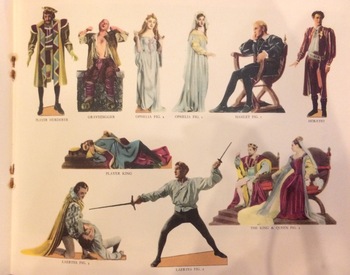This week’s SpeCol (Special Collections) Scoop comes from the Philbrick Collection, which is a massive collection of drama-related media donated to the school by the Philbrick family. One of these boxes is a collection of sets for toy theaters, which were somewhat like dollhouses with removable backgrounds and paper dolls. From what I can tell, toy theater companies chose short plays, gave plot synopses, usually in one act, provided the backgrounds for each scene, and gave the characters in various necessary positions for the play.
Some of these date back as far as the 1700s, which is, as always, incredible to see. The subject of this blog post, however, is from much more recently – 1948. In 1948 Sir Laurence Olivier did a highly-praised film version of Hamlet, which although an excellent play, is not exactly what I would call kid-friendly. When I was a wee one I enjoyed my fair share of dramatic sword fights, escaping from pirate ships, and even the occasional painful “death,” but, although this play has all these things and more, there are no real winners in Hamlet, except for maybe Fortinbras, who is often deleted from the play. The good guy exists in a morally gray area. This play is predominately about a man questioning himself and those around him, going on an emotional and physical journey that ends in death and sadness.
There seems to me to be something strange about explaining the trauma of the end of the play in a way that will be most easily actable and accessible for a group of young children. In the plot synopsis: “Finally, while picking flowers alone at the river’s edge, she falls in and is drowned.” It sounds like Ophelia tripped and fell (note the passive “is drowned,” removing all agency for her death!), rather than committing suicide thanks to the betrayal of those she loves and the murder of her father by her lover. Maybe it’s just the judgmental 1950s housewife in me speaking, but I can’t imagine that these emotionally challenging themes would be good play fodder for young children.

his version of Hamlet brings up some questions for me about what it means to experience the play in this child-friendly way. Is there an age too young for Shakespeare, or is it good to let children know about this classic play from an early age? The criteria for being “old enough” can’t just be that the reader understands Shakespeare, whatever that means; if so, then I don’t think anyone is really old enough for him. It is not possible to understand a work of art, exactly; even if Shakespeare had one interpretation in mind, we can’t know what that was and it isn’t important, because interpretations hold weight regardless of their Elizabethan relevancy. Is it possible that, as my reaction suggests, this and other similar interpretations are “missing the point” if no one can really say what the point is?
Looking at my earlier blog posts, I would have to say yes; just as with that Romeo and Juliet burlesque, my immediate reaction is a shade of disgust that belies a specific expectation for what it means to play Shakespeare. However, I plan with the rest of this summer to dig deeper into my expectations for Shakespeare, and in general, what it means to expect anything from a subjective performance. It isn’t necessarily fair that liberal adaptations have my mistrust, and I want to research how that and other expectations affect the experiences one can have in experiencing his work. Stay tuned for more personal and academic revelations on this theme!